Are you looking to revitalize your outdoor space while conserving water? Discover the joy of creating your own rain basin garden and add a unique touch to your yard. A rain basin garden is a landscaping feature that collects and filters rainwater runoff from your lawn, roof, and driveway. It not only enhances the beauty of your outdoor space but also plays a crucial role in water conservation.
By creating a rain basin garden, you contribute to reducing water waste and protecting the environment. Instead of letting stormwater runoff enter the storm drain system and eventually waterways, a rain basin garden collects and filters the water naturally through deep soil. This prevents pollution and helps maintain the natural water cycle.
Key Takeaways:
– A rain basin garden collects and filters rainwater runoff from your outdoor space.
– It helps conserve water and protects the environment.
– Creating a rain basin garden adds beauty and uniqueness to your yard.
So, why wait? Start planning and designing your own rain basin garden today and enjoy the benefits of water conservation and a beautiful outdoor space.
A rain basin garden: Capturing and Filtering Stormwater Runoff
A rain basin garden is a landscaped feature that replaces a portion of your lawn and helps collect and filter stormwater runoff, preventing it from entering the storm drain system. By creating a rain basin garden in your outdoor space, you can revitalize your surroundings while also contributing to water conservation efforts.
Stormwater runoff occurs when rainwater flows over surfaces such as roofs, driveways, and lawns, picking up pollutants along the way. This runoff often enters the storm drain system, which leads directly to local waterways. Rain basin gardens are designed to capture and naturally filter this runoff through deep soil, preventing pollution from entering our waterways.
A rain basin garden serves multiple purposes. It not only helps conserve water by retaining and filtering runoff, but it also reduces flooding and drainage problems in your yard. Additionally, rain basin gardens create an eco-friendly garden design that attracts birds, butterflies, and beneficial insects.
Key benefits of a rain basin garden include:
- Water conservation: By capturing and filtering stormwater runoff, rain basin gardens help conserve water and reduce the strain on local water sources.
- Eco-friendly garden design: Rain basin gardens are a sustainable landscaping solution that promotes biodiversity and creates natural habitats for wildlife.
- Stormwater management: These gardens prevent runoff from entering the storm drain system, reducing the risk of flooding and protecting local waterways from pollution.
Building a rain basin garden requires careful planning and consideration of factors such as location, size, and style. It’s important to choose a suitable area that can collect runoff and provide enough space for the garden to thrive. You may need to redirect downspouts or utilize a rain barrel to ensure a water source for your garden.
Once the location is determined, the next step is to excavate the base of the rain basin garden and fill it with an appropriate soil mix. Native plants that can tolerate both wet and dry conditions should be chosen for planting. These hardy plants require minimal watering, making rain basin gardens low-maintenance.
Maintaining a rain basin garden involves regular watering, mulching, and upkeep of the plants. The use of native plants in these gardens not only reduces the need for watering but also attracts pollinators and creates a thriving ecosystem.
When selecting plants for your rain basin garden, opt for native species that are adapted to the local climate and soil conditions. These plants are more likely to thrive and provide benefits to the environment. Consider a variety of flowers, grasses, and shrubs to promote biodiversity and enhance the visual appeal of your garden.
Rain basin gardens play a crucial role in improving water quality. By capturing and filtering stormwater runoff, these gardens help remove pollutants before they enter waterways, protecting local ecosystems and promoting a healthier environment.
In addition to their water quality benefits, rain basin gardens also contribute to biodiversity by providing habitat and food sources for local wildlife, including pollinators. These gardens create natural and self-sustaining ecosystems in urban areas, helping to support and protect native species.
In conclusion, a rain basin garden is a practical and eco-friendly way to revitalize your outdoor space while conserving water and improving water quality. By implementing the steps and considerations mentioned above, you can create a beautiful and functional rain basin garden that benefits both your yard and the environment.
Sources: TRCA Healthy Yards Fact Sheet, Rain Dog Designs, The Regenerative Garden.
Benefits of a Rain Basin Garden
By planting a rain basin garden, you can protect local waterways, conserve water, and create an eco-friendly garden design that enhances the beauty of your outdoor space. Rain basin gardens offer a range of benefits, making them a sustainable and practical choice for any homeowner. Here are some key advantages of having a rain basin garden:
| Water Conservation | Eco-Friendly Garden Design | Stormwater Management |
|---|---|---|
|
Rain basin gardens play a crucial role in water conservation. Instead of allowing rainwater to flow off your property, a rain basin garden captures and retains the water, allowing it to slowly infiltrate into the ground. This reduces the need for additional irrigation and helps replenish groundwater reserves. |
With an eco-friendly garden design, rain basin gardens promote sustainability and biodiversity. By using native plants that are adapted to local climate and soil conditions, rain basin gardens create natural habitats for birds, butterflies, and beneficial insects. These gardens also minimize the need for chemical fertilizers and pesticides, promoting a healthier environment. |
One of the major benefits of rain basin gardens is their ability to manage stormwater. These gardens act as natural filters, capturing and absorbing stormwater runoff from roofs, driveways, and other surfaces. By doing so, rain basin gardens prevent excess water from entering the storm drain system, reducing the risk of flooding and drainage problems in your yard and surrounding areas. |
In addition to these primary benefits, rain basin gardens also offer other advantages:
- They reduce erosion by slowing the flow of water and allowing it to be absorbed into the ground.
- They prevent pollutants such as fertilizers, pesticides, and sediment from entering waterways, protecting the quality of local streams, rivers, and lakes.
- They require minimal maintenance once established, as native plants are adapted to local conditions and require little to no watering.
- They can enhance the aesthetic appeal of your outdoor space, creating a beautiful and tranquil garden that attracts wildlife and provides a natural backdrop for relaxation and enjoyment.
“Rain basin gardens not only help conserve water but also provide an opportunity to create a sustainable and beautiful outdoor space. With their ability to manage stormwater and promote biodiversity, these gardens are an eco-friendly choice for any homeowner.”
Conclusion
By creating a rain basin garden, you can contribute to water conservation efforts, promote a sustainable and eco-friendly garden design, and manage stormwater effectively. Rain basin gardens offer a range of benefits, from reducing the risk of flooding to enhancing the beauty of your outdoor space. So why not start your own rain basin garden today and make a positive impact on your environment?

Getting Started with a Rain Basin Garden
Before you start creating your rain basin garden, it’s important to plan its location, style, and size to ensure its success in conserving water and managing stormwater runoff.
Location
When choosing the location for your rain basin garden, consider where the water will come from and how it will be directed into the garden. One option is to redirect your downspouts towards the garden, allowing rainwater from the roof to flow into the basin. You can also consider using an infiltration trench or an overflow pipe from a rain barrel to carry water into the garden.
It’s crucial to place the rain basin garden at least 3 meters away from any building foundation to prevent water from getting into the foundations and causing basement flooding. Avoid placing the garden within 4 meters of a septic bed or within 15 meters of any steep slopes as these can cause drainage and stability issues.
Before starting any digging, it’s important to locate and mark all underground utilities to avoid any accidental damage. Use the Ontario One Call online locate form or call 1-800-400-2255 to locate underground infrastructure before you dig.
Style
A rain basin garden can be designed to complement any style of landscape. Whether you prefer a formal or more casual look, there are endless options to choose from. Take inspiration from local rain gardens in your area or visit demonstration rain gardens to get ideas on different styles. Some examples of demonstration rain gardens in the Greater Toronto Area include Humber Arboretum, County Court, Kortright Centre for Conservation, Markham Museum, and Lake Wilcox.
Size
The size of your rain basin garden will depend on the area of land that will be contributing water to it. As a general rule, the ponding area in a rain basin garden should have a depth of 6-12 inches. The garden should be twice as wide as it is long, with the widest part at the lowest point of the slope. In rainy climates, the bottom inside of the garden should be 15% of the square footage of the runoff source.
Once you have determined the location, style, and size of your rain basin garden, you can proceed with the construction process.
| Location | Style | Size |
|---|---|---|
| Choose a location away from building foundations, septic beds, and steep slopes | Consider different styles like formal or casual | Size the garden based on the area of land contributing water to it |
| Redirect downspouts or use an infiltration trench or overflow pipe | Get inspiration from local rain gardens or demonstration gardens | Ponding area should have a depth of 6-12 inches |
| Locate and mark underground utilities | Choose a style that complements your existing landscape | Garden should be twice as wide as it is long |
Before you start digging, make sure to check for any underground utilities and plan the location, style, and size of your rain basin garden to ensure success in conserving water and managing stormwater runoff.
By carefully planning and considering these factors, you can create a rain basin garden that not only helps conserve water but also enhances the beauty of your outdoor space.
Building a Rain Basin Garden
Building a rain basin garden involves creating a shallow depression, filling it with the right soil mix, and selecting and planting native plants that can thrive in wet and dry conditions. This process will help you create a functional and beautiful rain basin garden that not only revitalizes your outdoor space but also contributes to water conservation and stormwater management.
Creating the Shallow Depression
The first step in building a rain basin garden is to create a shallow depression in your outdoor space. This depression will serve as the base for collecting and absorbing stormwater runoff. Start by marking the boundaries of the depression using stakes and string.
Next, use a shovel or a garden rake to dig the depression to a depth of around 6 to 8 inches. Make sure the depression is evenly sloped to allow water to flow and collect in the center. Pay attention to any underground utilities or poor drainage areas that may affect the location of your rain basin garden.

Filling the Depression with the Right Soil Mix
After creating the depression, it’s crucial to fill it with the right soil mix that promotes water absorption and filtration. A recommended soil mix for rain basin gardens is a combination of one-third compost and two-thirds garden soil. This mixture provides the necessary nutrients for plant growth and enhances water retention in the garden.
Start by spreading a layer of the soil mix evenly across the bottom of the depression. Make sure to leave enough space for the plants to be planted later. Smooth out the soil mix and gently pack it down to create a level surface.
Selecting and Planting Native Plants
The next step is to select and plant native plants that can thrive in wet and dry conditions. Native plants are well adapted to the local climate and require less maintenance. They also contribute to biodiversity and provide habitat for local wildlife.
Research native plants that are suitable for rain basin gardens in your area. Choose a variety of flowers, grasses, and shrubs that can tolerate both wet and dry conditions. Consider the height, color, and bloom time of the plants to create an aesthetically pleasing garden. Plant the selected plants in the soil mix, following the recommended spacing and depth for each species.
Maintaining the Rain Basin Garden
Once your rain basin garden is established, it’s important to maintain it to ensure its long-term success. Regular maintenance tasks include watering, mulching, and pruning. However, one of the benefits of rain basin gardens is their low maintenance nature due to the use of hardy plants that require little to no watering.
Monitor the garden for any signs of excessive moisture or drought stress in the plants. Water the garden only when necessary, focusing on the early morning or late afternoon to prevent evaporation. Apply a layer of mulch around the plants to conserve moisture and suppress weeds. Prune the plants as needed to maintain their shape and remove any dead or damaged foliage.
By following these steps and incorporating sustainable practices, you can create a beautiful and functional rain basin garden that not only enhances your outdoor space but also contributes to water conservation and stormwater absorption.
Maintaining a Rain Basin Garden
Maintaining a rain basin garden is easy and requires minimal effort due to the use of beautiful, hardy plants that are low maintenance. Once you have set up your rain basin garden, there are a few simple tasks to keep it thriving and ensure its long-term success.
Watering
Watering is usually not necessary once the plants in your rain basin garden are established. Native plants are adapted to the local climate and can tolerate both wet and dry conditions. However, if you experience a prolonged period of drought, it is important to provide supplemental water to help the plants survive.
Tip: Use a rain gauge to monitor rainfall in your area. If there is less than an inch of rain per week, consider watering your rain basin garden.
Mulching
Mulching is an important step in maintaining a rain basin garden. Applying a layer of organic mulch, such as wood chips or shredded leaves, helps conserve moisture, suppress weeds, and improve soil fertility.
Tip: Apply a 2-3 inch layer of mulch around the base of your plants, taking care not to pile it up against the plant stems.
Regular Upkeep
Regular upkeep of your rain basin garden involves removing weeds, pruning overgrown plants, and monitoring for any signs of pests or diseases. Weeds should be removed promptly, as they can compete with your native plants for water and nutrients.
Tip: Regularly inspect your rain basin garden for any signs of pests or diseases. If necessary, consult with a local gardening expert for advice on how to deal with specific issues.
By following these simple maintenance tasks, you can ensure the long-term health and beauty of your rain basin garden. Enjoy the benefits of a beautiful, eco-friendly garden while contributing to water conservation and stormwater management.
| Benefits of Maintaining a Rain Basin Garden |
|---|
| 1. Low maintenance – native plants require minimal care |
| 2. Water conservation – rain basin gardens reduce the need for supplemental watering |
| 3. Sustainable gardening – using native plants promotes biodiversity and creates natural ecosystems |
| 4. Beautify your outdoor space – rain basin gardens add aesthetic appeal to your landscape |
“Maintaining a rain basin garden is easy and requires minimal effort due to the use of beautiful, hardy plants that are low maintenance.”
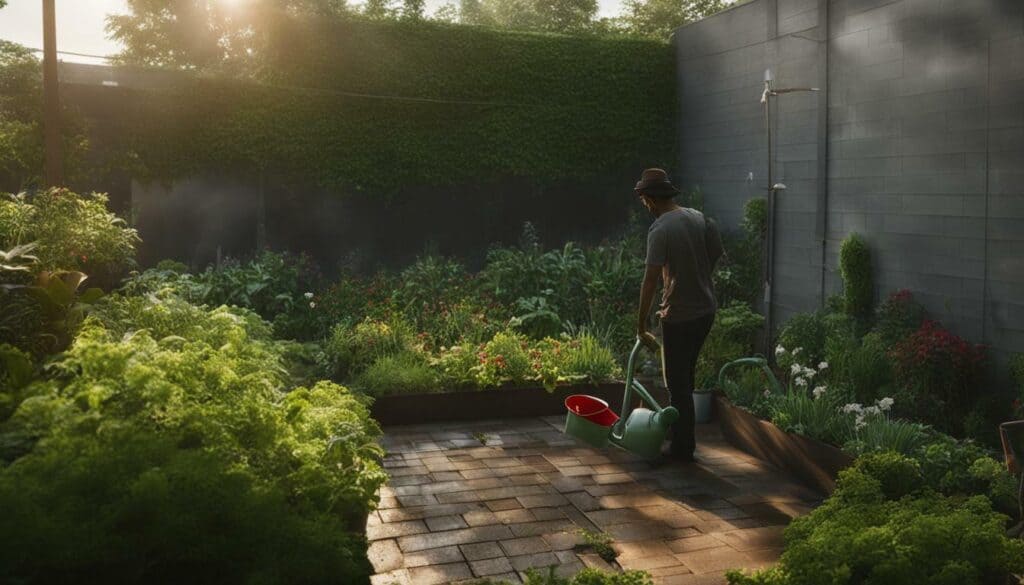
Native Plants for Rain Basin Gardens
When choosing plants for your rain basin garden, consider native species that can thrive in both wet and dry conditions while providing food and habitat for local wildlife. Native plants are well-adapted to the local climate and soil conditions, making them a perfect choice for sustainable landscaping. Here are some examples of native plants that are suitable for rain basin gardens:
| Plant Name | Growth Habit | Soil Moisture | Sun Exposure |
|---|---|---|---|
| Switchgrass (Panicum virgatum) | Grass | Medium to Wet | Full Sun to Partial Shade |
| Cardinal Flower (Lobelia cardinalis) | Perennial | Wet | Full Sun to Partial Shade |
| Marsh Marigold (Caltha palustris) | Perennial | Wet | Full Sun to Partial Shade |
| Virginia Bluebells (Mertensia virginica) | Perennial | Medium | Partial Shade to Full Shade |
| Joe-Pye Weed (Eutrochium purpureum) | Perennial | Wet to Medium | Full Sun to Partial Shade |
- Switchgrass: This native grass is known for its beautiful feathery plumes and can tolerate a wide range of soil conditions.
- Cardinal Flower: With its vibrant red flowers, this perennial attracts hummingbirds and butterflies, making it a great addition to any rain basin garden.
- Marsh Marigold: This wetland plant produces bright yellow flowers in early spring and can add a pop of color to your rain basin garden.
- Virginia Bluebells: These lovely blue flowers bloom in the spring and thrive in shady areas, adding a touch of elegance to your garden.
- Joe-Pye Weed: With its tall, pinkish-purple flowers, this perennial is a favorite among pollinators and can thrive in wet to medium soil conditions.
These are just a few examples of the many native plants available for rain basin gardens. Do some research to find out which native plants are suitable for your specific region and soil conditions. Adding a variety of native plants to your rain basin garden will not only create a beautiful and vibrant landscape, but also support local wildlife and contribute to the overall health of your ecosystem.
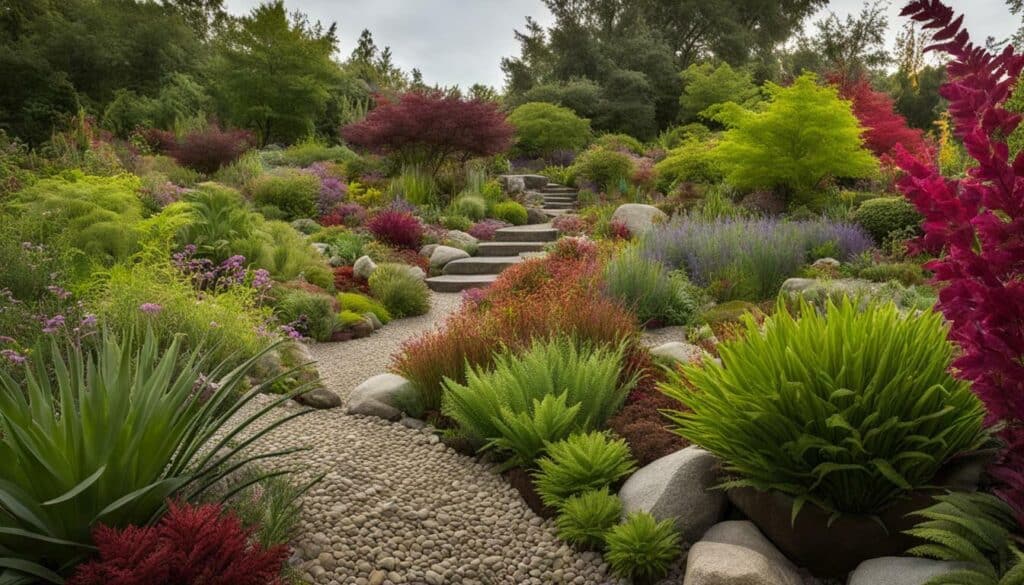
Rain Basin Gardens: Improving Water Quality through Stormwater Filtration
Rain basin gardens play a crucial role in improving water quality by filtering stormwater runoff and preventing pollutants from entering our waterways. These innovative gardens are designed to capture and absorb rainwater, reducing the amount of runoff that flows into storm drains and eventually into rivers, lakes, and oceans.
When it rains, water collects on roofs, driveways, and lawns, picking up pollutants such as fertilizers, pesticides, bacteria from pet waste, and eroded soil. Traditional drainage systems direct this polluted runoff into storm drains, which often lead directly to water bodies without any filtration or treatment. This results in water pollution and damage to local ecosystems.
Stormwater Runoff and Water Pollution
Stormwater runoff is the water that flows over land during precipitation events instead of soaking into the ground. It picks up a variety of contaminants along its path, including fertilizers, pesticides, bacteria, road salt, and litter. Without proper management, stormwater runoff can pollute our waterways and harm aquatic life.
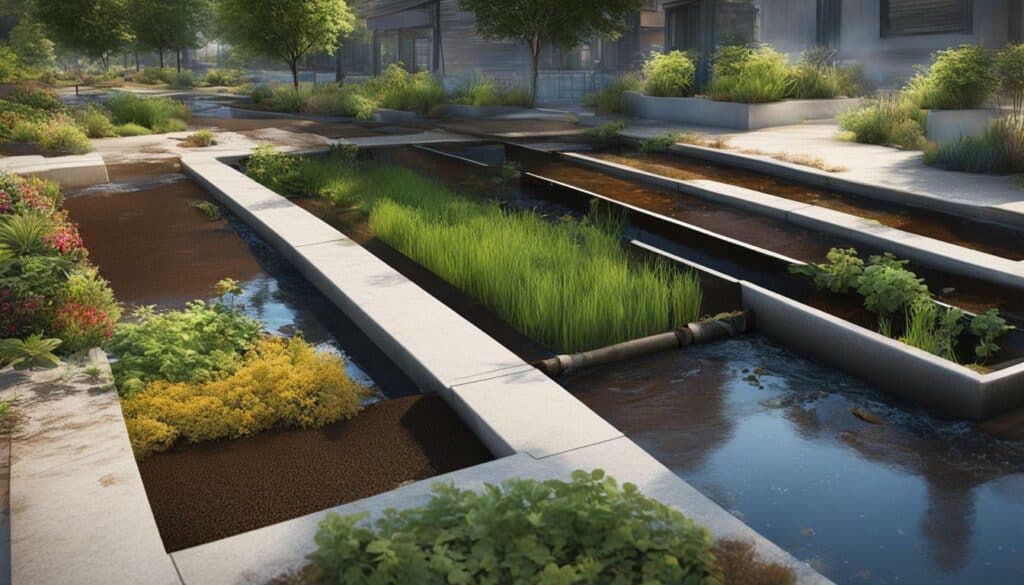
Stormwater runoff is the main cause of stream water pollution.
Rain basin gardens act as natural filters, capturing and absorbing stormwater runoff before it enters water bodies. The shallow depressions of these gardens collect the runoff, allowing the water to gradually permeate into the ground. The soil in rain basin gardens is specially amended to improve infiltration and filtration, removing pollutants and impurities from the water.
The Benefits of Rain Basin Gardens
- Water Quality Improvement: By filtering stormwater runoff, rain basin gardens help improve water quality in our rivers, lakes, and oceans. They remove contaminants and reduce the amount of pollution entering our waterways.
- Water Conservation: Rain basin gardens help conserve water by capturing rainwater and allowing it to gradually infiltrate into the ground. This reduces the need for additional irrigation and helps replenish groundwater supplies.
- Stormwater Management: These gardens mitigate the impact of heavy rainfall by capturing and storing rainwater, reducing the risk of flooding and erosion. They also help to regulate the flow of stormwater, preventing sudden and excessive runoff into water bodies.
Building and Maintaining a Rain Basin Garden
Creating a rain basin garden involves careful planning and design. The location, size, and style of the garden should be considered to ensure optimal functionality and aesthetic appeal. Rainwater can be directed to the garden using downspouts or rain barrels, and the base of the garden should be properly prepared with amended soil for efficient absorption.
Maintaining a rain basin garden is relatively low maintenance, thanks to the use of native plants that are well-suited to local climatic conditions. Regular watering, mulching, and upkeep of the plants will help ensure their health and the continued functionality of the garden.
Native Plants for Rain Basin Gardens
When choosing plants for a rain basin garden, it is important to select species that can tolerate the wet and dry conditions that the garden may experience. Native plants are an excellent choice as they are adapted to the local climate and provide habitat and food for local wildlife. Examples of native plants suitable for rain basin gardens include flowers, grasses, and shrubs.
Conclusion
Rain basin gardens are a sustainable and eco-friendly way to improve water quality, conserve water, and manage stormwater runoff. By creating these gardens, homeowners can make a positive impact on the environment and contribute to the health of their local waterways. Start your own rain basin garden today and revitalize your outdoor space while protecting our precious water resources.
Rain Basin Gardens and Biodiversity
Rain basin gardens serve as important habitats for wildlife, including pollinators, by providing food and shelter through the use of native plants. These gardens play a crucial role in promoting biodiversity and creating natural ecosystems within urban areas.
Native plants are essential for attracting and supporting local wildlife. They have co-evolved with the local ecosystem and are adapted to the specific climate, soil conditions, and insect populations of a region. By planting native plants in rain basin gardens, you can provide a sustainable food source and habitat for birds, butterflies, bees, and other beneficial insects.
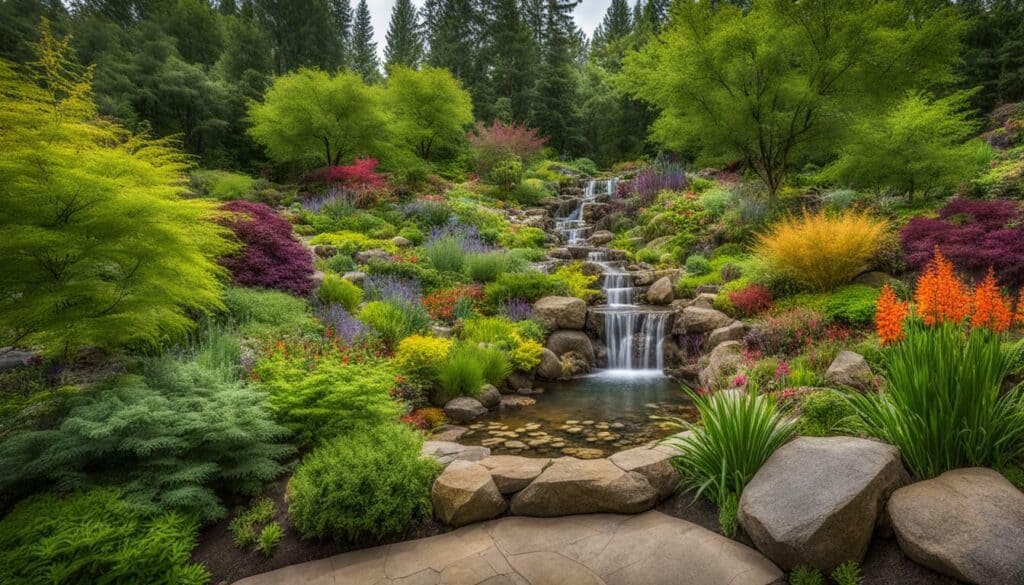
Native plants in rain basin gardens contribute to biodiversity in several ways:
- Food Source: Native plants produce flowers, fruits, and seeds that serve as a source of food for birds and insects. They attract a wide range of pollinators, including bees, butterflies, and hummingbirds.
- Habitat: The dense foliage and structure of native plants provide shelter and nesting sites for birds and small mammals. They offer protection from predators and harsh weather conditions.
- Breeding Grounds: Rain basin gardens with native plants can support the life cycle of insects, such as butterflies and moths, which lay eggs on specific plant species. These plants serve as host plants for caterpillars, ensuring the survival of these species.
- Ecological Balance: By promoting a diverse range of plant species, rain basin gardens help maintain a healthy and balanced ecosystem. They support the natural interactions between plants, animals, and microorganisms, ensuring the overall health of the environment.
When selecting plants for your rain basin garden, choose native species that are adapted to the local climate and soil conditions. Consider including a mix of flowers, grasses, and shrubs to enhance the biodiversity and visual appeal of your garden. Some examples of native plants suitable for rain basin gardens include:
| Plant Name | Type | Bloom Time |
|---|---|---|
| Milkweed | Perennial | Summer |
| Black-eyed Susan | Perennial | Summer |
| Joe-Pye Weed | Perennial | Summer |
| Butterfly Weed | Perennial | Summer |
| Switchgrass | Grass | Fall |
| Blazing Star | Perennial | Summer |
By incorporating native plants into your rain basin garden, you can create a vibrant ecosystem that supports local wildlife, improves biodiversity, and contributes to the overall health of the environment. Start your own rain basin garden today and make a positive impact on the world around you.
Creating a Rain Basin Garden
Creating a rain basin garden is a rewarding way to revitalize your outdoor space while conserving water and contributing to a healthier environment. By implementing this eco-friendly garden design, you can transform your outdoor space into a vibrant oasis that not only beautifies your surroundings but also helps to manage stormwater runoff and prevent water pollution.
Revitalize Your Space
A rain basin garden offers a unique and visually appealing way to revitalize your outdoor space. Instead of traditional landscaping, which often requires excessive watering and maintenance, a rain basin garden uses natural processes to filter and absorb rainwater. With the right landscape design, you can create an outdoor space that is both aesthetically pleasing and environmentally friendly.
Water Conservation
One of the key benefits of a rain basin garden is its ability to conserve water. By collecting and filtering stormwater runoff from your lawn, roof, and driveway, a rain basin garden helps to reduce the strain on local water resources. This is particularly important in areas prone to drought or water restrictions, as it allows you to maintain a lush garden while minimizing your water usage.
Stormwater Management
Rain basin gardens play an important role in stormwater management. By collecting runoff from impervious surfaces, such as concrete or asphalt, rain basin gardens prevent excess water from entering the storm drain system. This helps to reduce flooding and drainage problems in your outdoor space and prevents pollutants from entering local waterways.
Getting Started
To get started with your own rain basin garden, you’ll need to consider a few important factors. First, determine the location, style, and size of your garden. Ideally, your rain basin garden should be located away from buildings, at least three meters away from any foundation. It should also be relatively flat, with a slope between 1% and 5%.
Next, consider the water source for your rain basin garden. You can redirect downspouts to feed water into the garden or use a rain barrel to collect and distribute rainwater. It’s important to evaluate the availability of a water source before proceeding with your garden design.
Lastly, take into account any potential challenges that may arise during the construction of your rain basin garden. This includes the presence of underground utilities, poor drainage areas, and any restrictions imposed by local regulations. By planning ahead and addressing these challenges, you can ensure a successful and functional rain basin garden.
Building Your Rain Basin Garden
Building a rain basin garden involves several steps to ensure proper water absorption and filtration. The first step is to dig a base for your garden, typically around 24 inches deep. This will provide the necessary volume to hold stormwater runoff. Fill the base with a well-draining soil mix, composed of one-third compost and two-thirds garden soil.
Once the base is prepared, create an overflow area to release excess water, preventing flooding in your garden. This can be achieved by constructing a gravel-filled trench along the edge of the garden or installing an overflow pipe. Finally, select and plant native plants that can tolerate wet and dry conditions, ensuring your rain basin garden thrives while providing natural filtration and habitat for wildlife.
Maintaining Your Rain Basin Garden
Maintaining a rain basin garden is relatively low maintenance, thanks to the use of hardy native plants that require minimal watering. However, regular upkeep is still necessary to ensure the ongoing health and beauty of your garden. This includes watering during dry periods, mulching to retain moisture and suppress weeds, and monitoring for any signs of pests or disease.
Enhancing Biodiversity
A rain basin garden contributes to biodiversity by providing a habitat for wildlife and supporting pollinators. By choosing native plants for your garden, you can attract birds, butterflies, and beneficial insects, creating a thriving ecosystem in your outdoor space. Native plants are adapted to the local climate and soil conditions, making them resilient and well-suited to rain basin gardens.
Conclusion
A rain basin garden offers a unique and sustainable way to revitalize your outdoor space while conserving water and benefiting the environment. By implementing a rain basin garden, you can create a beautiful and eco-friendly garden that reduces stormwater runoff, prevents water pollution, and supports local biodiversity. Start your own rain basin garden today and enjoy the many benefits it brings to your outdoor space.
FAQ
Q: What is a rain basin garden?
A: A rain basin garden is a landscaped feature that collects stormwater runoff from roofs, lawns, and driveways, filtering it naturally through a deep soil, preventing it from entering the storm drain system and, eventually, our waterways.
Q: What are the benefits of a rain basin garden?
A: Rain basin gardens help conserve water, reduce flooding and drainage problems, prevent pollutants from entering waterways, restore and recharge the groundwater system, and attract birds, butterflies, and beneficial insects.
Q: How do I get started with a rain basin garden?
A: To get started, you need to plan the location, style, and size of your garden. Consider the availability of a water source, such as a downspout or a rain barrel. Ensure that the location is at least 3 meters away from any building foundation and relatively flat.
Q: How do I build a rain basin garden?
A: Building a rain basin garden involves digging the base, filling it with a soil mix of compost and garden soil, and creating an overflow area to release excess water. It’s important to locate and mark all underground utilities before digging.
Q: How do I maintain a rain basin garden?
A: Rain basin gardens are low maintenance and require little to no watering. Regular upkeep of the plants, including watering as needed, mulching, and weeding, is recommended.
Q: What are some native plants suitable for rain basin gardens?
A: Native plants that can tolerate wet and dry conditions are ideal for rain basin gardens. These include a variety of flowers, grasses, and shrubs, promoting biodiversity and providing habitat for local wildlife.
Q: How do rain basin gardens help improve water quality?
A: Rain basin gardens act as filters, removing pollutants from stormwater runoff before it enters waterways. They help reduce water pollution and protect local ecosystems.
Q: What is the role of rain basin gardens in promoting biodiversity?
A: Rain basin gardens using native plants provide food and habitat for local wildlife, including pollinators. They play a key role in creating natural and self-sustaining ecosystems in urban areas.
Is Basil Garden Italian Restaurant Known for Authentic Dishes?
Savor authentic italian dishes at basil garden, the renowned Italian restaurant. With a delectable menu ranging from classic pastas to flavorful pizzas, Basil Garden ensures an authentic culinary experience. Indulge in the rich flavors and savory aromas that have made this restaurant a go-to destination for Italian cuisine enthusiasts.

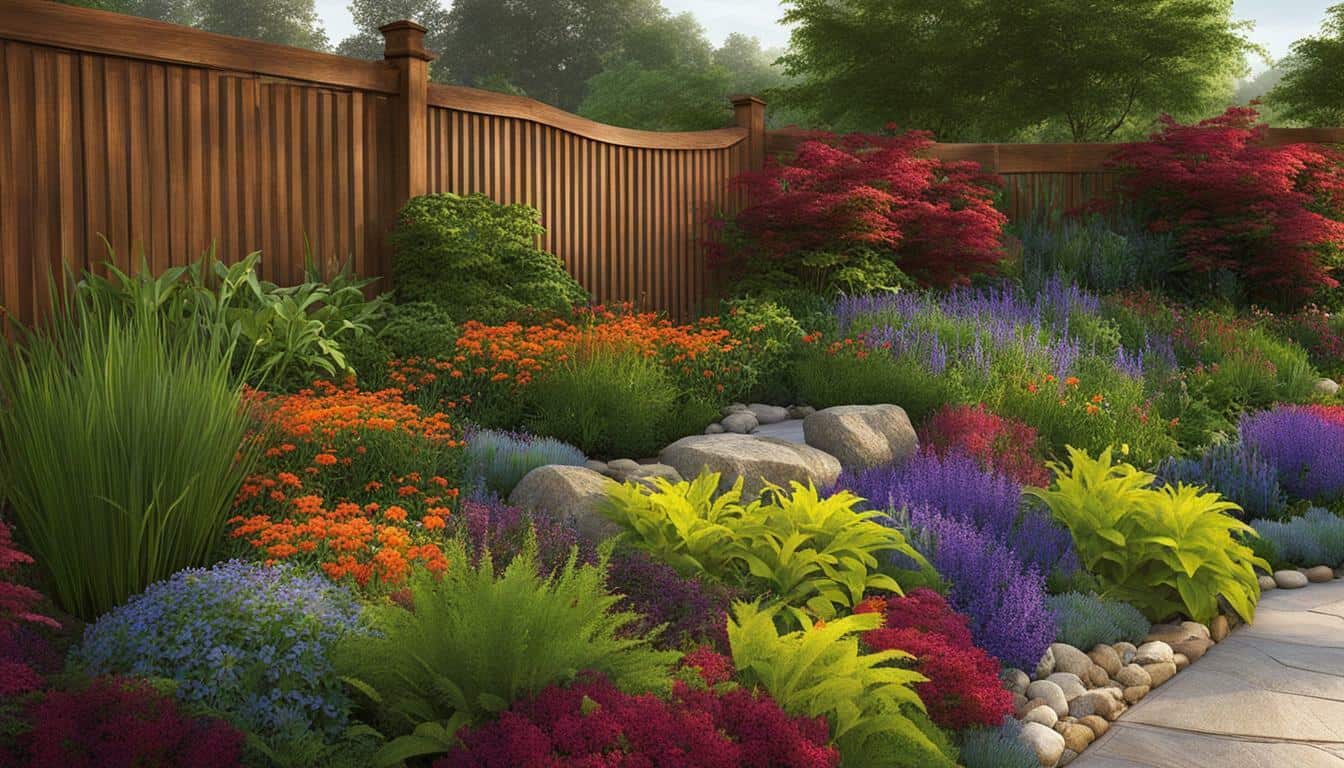



Leave a Reply